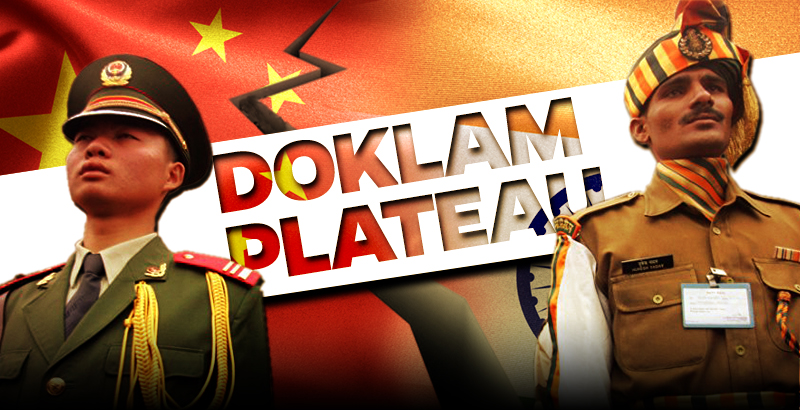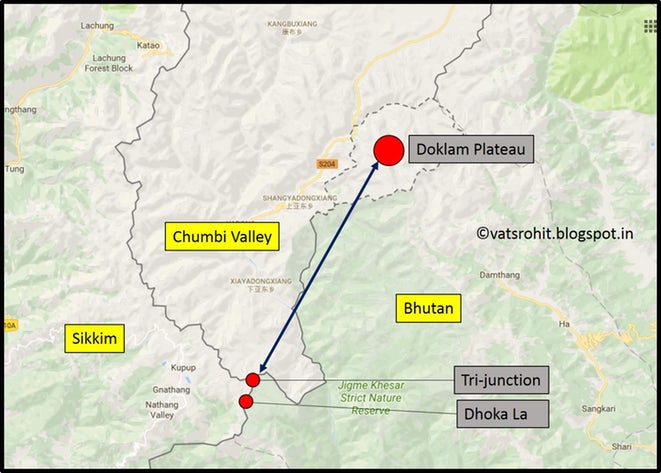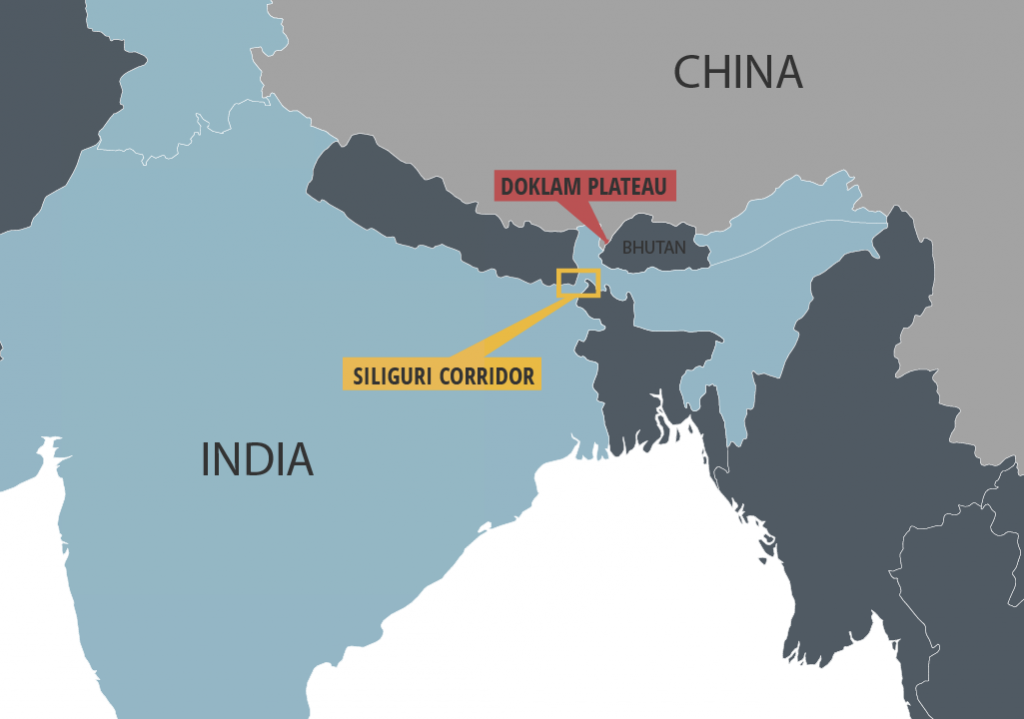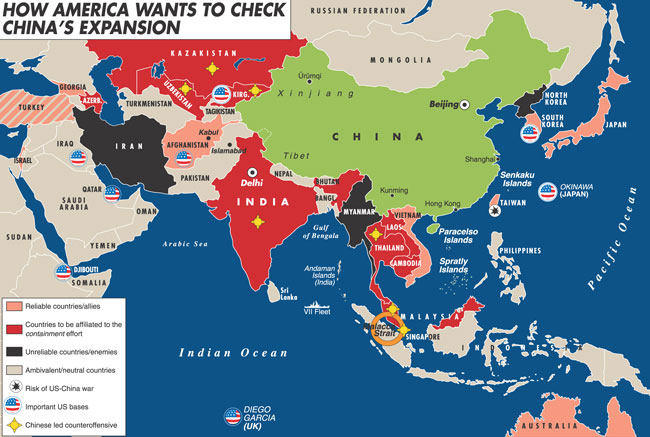
Written by J.Hawk exclusively for SouthFront
In June 2017, Chinese effort to extend a road on the Doklam Plateau provoked a militarized confrontation as India rushed troops to the area in order to prevent the construction. On July 2, 2017, the head of the, the People’s Republic of China Ministry of Defense Center for International Security Cooperation Zhou Bo warned that Indian forces on the Doklam Plateau ought depart the area, lest they wish to provoke Chinese military action. In response, Indian authorities ordered ethnic Chinese villagers on the plateau to evacuate themselves from the area.

The plateau status is a subject of dispute between the PRC and the Kingdom of Bhutan, the latter being a close ally of India which supports Bhutan’s claim to it, fearing that China’s control would endanger the Siliguri Corridor, the so-called “Chicken’s Neck”, a relatively strip of land that connects India’s eastern provinces to the rest of the country. Considering that the escalation of tensions with India is coinciding with aggressive US moves in the South China Sea, the warlike US rhetoric aimed at North Korea, the threat of US economic warfare against China’s alleged “unfair trade practices”, and also an escalation of fighting between Pakistan and India in Kashmir, the Doklam Plateau confrontation should not be viewed in separation from the other developments.

Toward Double Containment
It was evident already in the late 1990s that Washington was viewing China as the next challenger to its hegemony and was taking measures to ensure China’s power could be crippled, when necessary. The world has lived in the shadow of 9/11 for so long that it’s easy to forget the April 2001 EP-3 incident near Hainan Island, or Secretary of Defense Donald Rumsfeld’s efforts to reorient the US military toward waging space-aero-naval warfare against an unspecified nuclear-armed adversary that, while unnamed, was almost certainly China. The pre-9/11 plans to reduce US Army’s divisions very much suggest this doctrine was not being prepared against Russia.
However, 9/11 intervened and distracted the US for well over a decade, during which Russia staged a spectacular recovery which prompted the Obama Administration to view the weakening of Russia as a middle-term objective in the ultimate effort to politically subjugate China. One can readily imagine a President Navalny, Kasyanov, or Nemtsov cooperate with the US in depriving China of the ability to procure Russian gas, oil, and military technology.
With Russia proving a tougher nut to crack than Obama Administration anticipated, Trump appeared to opt for an alliance with Russia against China. It can be most charitably described as a vain hope–US post-Cold War foreign policy has been so duplicitous and opportunistic that no Russian president could possibly trust the US to hold up its end of the bargain in that kind of a relationship, which means that Russia and China are far more likely to view each other as credible partners than the US. But Trump’s apparent plan was quickly thwarted by the US “deep state”, and the two sides seem to have reached a compromise by…simultaneously launching a “cold war” against Russia and China.
A pro-US map shows the alleged situation in the region in light of the US-China geopolitical standoff:

The stepped up confrontations in the South China Sea, the US outreach to India, Myanmar, Philippines, and Vietnam, the tough talk of economic sanctions in response to alleged Chinese aluminum and steel “dumping” and “intellectual property” violations, and most recently the use of North Korea’s highly exaggerated nuclear “threat” as a means to justify economic sanctions against Chinese entities (the last step highly reminiscent of the use of Ukraine to launch economic warfare against Russia), are all part of the US “cold war” against China. This war has not yet escalated to the “hybrid” level (unless one counts the support for the “pro-democracy” movement in Hong-Kong), but the trend is unmistakable.
India, in particular, seems to play an important role in this scheme, and unfortunately Narendra Modi has not been able to resist the temptation of seeking Western favor in return for his participation in the containment of China. While India has long been a major procurer of Russian weapons, there is an evident drift in the direction of the US and the EU, with the purchase of Rafale fighters, P-8 maritime patrol aircraft, and AH-64 Apache attack helicopters. In August 2017, US Pacific Command commander Admiral Harry Harris said the US stood ready to help India modernize its armed forces, and the Indian procurement of US weapons is expected to rise into the billions of dollars in coming years. India’s potentially hostile stance toward China, and its potential ability to dominate the Indian Ocean, could spell trouble for China’s maritime trade routes to the Middle East, Africa, and Europe.
The Middle Kingdom Strikes Back
It is equally evident that China does not intend to sit idly by and watch itself become encircled by a US-led alliance capable of curtailing its trade with the EU. One can see these efforts in Beijing’s unyielding stance on South China Sea, the growing rapprochement with Russia, continued alliance with Pakistan, a base in Djibouti, and now the confrontation on the Doklam Plateau.
If the situation were to escalate, it would be the first large-scale conflict between India and China since the brief 1962 war in Aksai Chin and the North-East Frontier Agency in which India suffered some 7 thousand irretrievable military casualties (killed, captured, missing), or about 10 times PLA’s losses.
While that conflict took place over five decades ago, it is likely that in a new clash the outcome would be largely similar. While India’s military prides itself on having combat experience in Kashmir, that conflict is of a protracted, debilitating kind that actually undermines combat effectiveness and morale. While the PLA lacks recent combat experience, it is evident from its appearances at a variety of Army Games in Russia, including the Tank Biathlon, that it is striving to attain a high degree of proficiency. The recent demonstration of a brand new light tank design to be used in mountainous terrain unsuitable for MBTs suggests doctrinal and equipment adaptation to a variety of theaters, including the Sino-Indian border. Finally, in any such conflict China’s heavy investment in Tibet infrastructure would give it the upper hand over India, since the conflict would in the end come down to the ability to sustain a large fighting force on the “roof of the world.”
Conclusions
But Beijing’s aim does not appear to be the Plateau itself. Rather, Beijing appears to be signaling to New Delhi its intent to make its potential anti-China moves in an alliance with the US costly. The Doklam Plateau could become yet another low intensity frontline for India, to be added to Kashmir.
Russia, being a strategic partner to both powers, is caught in the middle of this dispute, which makes it an ideal candidate for mediating the conflict. The golden opportunity to do so is right around the corner: the September 2017 BRICS summit that will be held in China. Barring a local incident that triggers an escalation, it is unlikely either side will make any decisive moves prior to a diplomatic face-off.






If India wishes to modernise its armed forces it should look to Russia rather than the USA. Their weapons are cheaper, of better quality and they will be delivered.
But what an interesting, informative article on something that is occasionally mentioned but never explained in the media – thank you.
Russia betrayed India. Therefore india is pissing on russia.
They can live in the past or move into the future. Their choice.
this is the present. india gave money for su50 project, hat this will be common fighter. and now russians stole everything. russdia has finished in india. and nobody will support with money russian projects of russian thiefs.
The same with the US ripping off everyone consistently with their failed projects being able to deliver. The F-35 is a sinkhole for corrupt businessman that the US Hundreds of billions sunk in to a garbage plane given to Israel who spent next to nothing and were given first purchase rights above others.
so, i know, israel is very satisfied with f-35s.
The US betrays everyone in the end and throws all it’s allies under the bus after they have used them for their gains of ill gotten wealth and power. The fact even India is an enemy to the US is why they chose to use them up against China , just Indians go on being Good-Good for the Ghoru-Saahib.
dont change. now we discuss about russian traitors.
Would you kindly expand on the su50 project , as objectively as you can .
in the beginning:
Following the success of the BrahMos project, Russia and India agreed in early 2007 to jointly study and develop a Fifth Generation Fighter Aircraft (FGFA) programme.[8][9] On 27 October 2007 Sukhoi’s director Mikhail Pogosyan stated: “We will share the funding, engineering and intellectual property in a 50–50 proportion”, in an interview with Asia Times.[10] On 11 September 2010, it was reported that India and Russia had agreed on a preliminary design contract, subject to Cabinet approval. The joint development deal would have each country invest $6 billion and take 8–10 years to develop the FGFA fighter.[11]
today:
http://thediplomat.com/2017/05/india-russia-5th-generation-fighter-jet-deal-is-lost/
in nutshell: russian needed indian money, otherwise the su-20 project could not benn started. india gave moiney, particioated on development. and now russia makes everything to avoid that india could have 5th generation fighter.
there were also problems with mig-29/29k. india is disappointed. and this is not good for russia. indians slowly become the most important country in space transport. they have good rocket technology, good engines, good engineers and scientists. china makes also lomg steps. one day can happen, thet russia will be not important for other countries in this field.
I have doubt that the present Modi government at New Delhi will accept Russia as the mediator. It’s a fascist, right wing govt. and the basic intention behind this quarrel with China is to please US.
if not for india, china would have succeded in bullying tiny nation of Bhutan, China is not happy because it wants to repeat south china sea even in the himalays.
The role of Indian govt. in this case isn’t like an angel. And after all, what happened should be between China and Bhutan. Why India is meddling in between? Do Bhutan asked for that? As far as I know the answer is “NO”.
India has traditionally protected Bhutan ( Buddhist ) , first from the Muslims , and they do have treaty alliances at present . But you are right in that Modi , is foolishly falling under American influence , especially the surrender in banking .
if countries like vietnam and phillipines can not stand upto china how can tiny kingdom can stand upto an emerging superpower china, If united states do not want to check China coz of its own economic interest , then other power like Russia, Japan, Australia should check china expansinist policy and its human rights records, I guess there is an agreement between Bhutan China to look after its security. More over after Bhutan , China may target india itself as they share long Himalayan pleatue.
You are describing the matter in such a way as if China is trying to invade Bhutan and India is just humble protector of Bhutan. Better sell your “patriotism” elsewhere.
you are arrogant. went the flag.
i am a full blood pakistani and has nothing to do with my “patriotism”
india is ally of bhutan. more ally then russia to syria.
Russia has intervened in Syria when the govt. asked for help. Does the Bhutan govt. asked for help from India? The way everything has been done seems like India is the keeper and Bhutan is the kept.
yes, bhutan asked for help
As far as I know, the King of Bhutan has requested both parties to remove their soldiers. And Crimea isn’t a separate state that can ask for help. What happened is that the Crimean people make a referendum for themselves and Russia acknowledged the referendum. You are distorting facts to make logic for the actions of Indian state.
Russia, being a strategic partner to both powers,
Russia is ONLY low businees partner for both.
I don’t share J.Hawk’s sympathy for China’s thievish colonialism. They seem to believe that they live in the 19th century US that made and tore up treaties with the Indians at random.
Until now the US has done nothing against China like Hawk claims. In the South China Sea they have made some noise that seemed mainly meant to give the impression that they did something against China’s obviously outrageous behavior – while in fact they did nothing.
When thirty years ago Japan was at its top as fas growing exporter the noise about unfair trade practices and theft of intellectual property was much stronger than now. My impression is that China is handled with kid gloves.
The article is rather incomplete in its description of what the conflict is about. The map shows what is contested territory according to Bhutan and India. However, China’s claims go further. It claims a stroke of territory along Bhutan’s west border all the way down to below Dhoka La. If you keep that in mind the building of a road on the Doklam Plateau is the first step in something that is meant to go much further.
Many Chinese writings do support J Hawk’s view here, especially articles from China’s Global Times. Also, I’d like to suggest you do more research on how the former Royal Kingdom of Sikkim got annexed into Indian territory. Here is an eye opener blog post by a blogger from Bhutan about Doklam situation at http://wangchasangey.blogspot.com/2017/08/the-strategy-behind-india-doklam.html .
South China Sea situation was stem from the Pivot to Asia strategy. Aside from the oils, do you know that South China Sea houses China’s strategic nuclear submarine base and thus their operations there? And, do you know that more than 80% of the cargoes which include the much needed oils go through SCS to China?
If a war does break out, it would not be fought like the way it was with Pakistan. For China, a long simmering war would turn the two countries into enemies anyways. If it takes out the eastern portion of India, it would, in one felt swoop, gain land access to the Indian Ocean via Bangladesh and have the ability to pose a bigger threat to India from both oceans.
this will not allow neither russia, nor usa. then declare wr to china.
Some what agreed. If India doesn’t retreat from Doklam, China will eventually make India an example to the world and specifically to countries like Vietnam and Philippine. Just like in 1962, China will attack from both the West (Aksai Chin) and East (Arunachal Pradesh aka South Tibet) borders with India.
Olive it looks u r still living in 1962 era when India was never prepared for any war and even didnt have proper weapons… If war start India will repeat 1967 when chinese army ran away and chinese casualty was more then 5 times of india
India had much better weapons and better equipped than China back in 1962. Indian army had all the supplies by USA and Russia. India was warned countless times like how it is happening today. Then Prime Minister Jawaharlal Nehru just miscalculated China and Mao like all other conflicts in Korean war and the brief border war with the Soviets in 1969, so it’s a lame excuse to say that Indian army never prepared.
Indian was better prepared !!, I will die laughing.. About India preparedness go and read neutral report but not from what your gov teaches you where even media is also not free to say but controlled by gov. In 1967 India better prepared but still weaker then china in military but still beat china in Sikkim sector. Reality is even china is stronger in military but they can’t go for war because they know very well small scale war will escalate to full scale in no time. In full scale its wont be then two nation war, more country will join and if not join, even though India will be destroyed badly, china too will be destroyed. And if nuke used, then India & China both will be history to word.
India was no match to China not because of the weapons or preparedness; rather, it’s the Chinese PLA’s tactics and experience from their civil war and the Korean war.
China reportedly has ‘Border dispute / claims’ with some 22 neighboring countries. That tells a story.